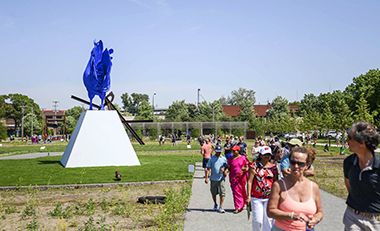The Urban Erosion
- Mesma Belsaré

- Apr 19, 2019
- 4 min read

In his 1929 essay titled Nottingham and the Mining Country, the ‘Green Novelist’ D. H. Lawrence wrote, “The real tragedy of England, as I see it, is the tragedy of ugliness. The country is lovely: the man-made England is so vile.” Mechanical and disintegrated is how Lawrence saw England reeling from the effects of the industrial revolution. A host of poets, writers and artists including Marcel Proust, Robert Frost, Virginia Woolf, James Joyce, T. S. Eliot, Vincent Van Gogh, Henri Rousseau, Paul Gauguin and Edouard Monet among many others echoed this sensibility. The harshness of a mechanized world was so painful that they fled from it in their work.
On the other hand the Futurist Movement founded in 1909 by the Italian poet and art theorist Filippo Tommaso Marinetti favored speed, newness, technology and all things industrial, even violence and war over the old aesthetic. "Undermine the foundation of venerable towns…a roaring motorcar…is more beautiful than the Victory of Samothrace"* Marinetti wrote in his manifesto. The Futurists frantically idolized modernity and objects related to it such as the railways, locomotives, airplanes, cars, tunnels and all machinery while ignoring their effects on the environment and people’s health. They apparently did not mind the transformation of the earth into a wasteland. The effect of Futurism on 20th century visual culture can hardly be ignored. Interestingly Marinetti also authored what was called the Fascist Manifesto.
But I digress…
I am a resident of Boston, Massachusetts. I have visited the Twin Cities frequently since 2002, when I met my partner, a Minneapolis resident. During my first summer visit to Minneapolis it was the beauty of the flora that struck me. Trees were taller and grander than on the East Coast; sumptuous gardens adorned private homes and a lush lattice of leaves pleasantly softened the urban concrete. The tree-lined downtown streets, the green elevations of Peavey Plaza, the verdant Minneapolis Sculpture Garden at the Walker Museum, the fragrant Lake Harriet Rose Garden: all seemed extraordinarily beautiful. To someone acclimated to Boston’s compressed landmass, the cities’ expanse of green was refreshing. Towering elms, oaks and ashes lived in my memory long after I left. It seemed like a D. H. Lawrence kind of place. “Virginia Woolf would’ve loved strolling by here,” I thought. “A haven for T.S. Eliot.”
But all that started to change. To my dismay I have returned in the past few years to the increasing denuding of the Minneapolis green canopy, dead wooden stumps along sidewalks, barks marked with the dreaded ‘X’ and the gray urban concrete gratingly exposed. Gone are the colorful planters on downtown’s gray-metal-themed Nicollet Mall along with most of the green paradise of the Walker Museum's Sculpture Garden. The Rice Park Renovation Project in downtown St. Paul also proposes to take down trees. It is ironic that the Minneapolis CPED (Community Planning and Economic Development) page on the city’s website claims to ‘grow a sustainable city’. The actions speak in contradiction to this claim. Words like ‘construction’, ‘renovation’, ‘remodeling’, ‘conversion’ and ‘addition’ abound, all pointing to a more mechanized mess of steel, glass and concrete. I was hard pressed to find plans to replace the ash trees that have been removed due to the unfortunate emerald ash borer affliction. In February 2017, The Star Tribune published an article titled ‘Minneapolis needs more trees - here’s why’ that detailed the benefits and the economic impact of reforesting the city. I will refrain from reiterating the content of the mentioned article***, except that trees don’t grow on concrete pavements!
Above: Images of the Sculpture Garden in Minneapolis; before renovation(left) and after (right)
Above: Images of the downtown Peavey Plaza; before renovation(left) and now (right)

All this makes one wonder if the ghosts of the Futurists are having a field day in today’s Minneapolis. Is utilitarianism the only value we have come to cherish? This compromise is not only ecological, but also aesthetic. As an art professional I am fully aware that aesthetic principles are hard to monetize. They are useless to the pragmatic economist. But ecology isn’t. It has grave repercussions when out of balance. I am neither an economist nor an ecologist. But I like spending my money in cities where ‘beauty’ is not a dirty word. If the Twin Cities continue to strip their emerald jewels, they will eventually lose their inherent beauty and by extension, their lure for visitors.
Tensions between the Eliots and the Marinettis have persisted through time. But the questions remain. What value system influences our decisions today? Are we aware of the long-term consequences of these decisions? My hope is that the Minneapolis city planners will realize the necessity of reinstating the flora that is native to its land and nurture it, lest it becomes T.S. Eliot’s ‘stony rubbish’ where ‘the dead tree gives no shelter, the cricket no relief, and the dry stone no sound of water’**. Consider this a plea from a visitor who longs to see, once again, the leafy citadels of Minneapolis and would like to keep coming back to them.
-Mesma
Notes:
* I Manifesti del Futurismo by Filippo Tommaso Marinetti first published in the French newspaper Le Figaro on February 20, 1909
**The Waste Land by T.S. Eliot
City images courtesy:
Minneapolis Park and Recreation Board
Minneapolis Public Works
Related:











Comments